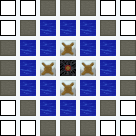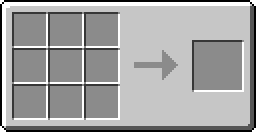Difference between revisions of "Water Mill"
m |
Eyekantspel (talk | contribs) m (Grammar, spelling, naming) |
||
| Line 14: | Line 14: | ||
Sounds simple, doesn't it? | Sounds simple, doesn't it? | ||
But | But I hope you didn't forget about the good ol' times, eh? You know, the times when people were actually WORKING for their lives? The ''Water Mill'' is for THAT kind of person. | ||
If you want to use it, fine, but keep in mind '''it needs a constant supply of fresh water''' to charge [[RE Battery]] | If you want to use it, fine, but keep in mind '''it needs a constant supply of fresh water''' to charge [[RE Battery|RE Batteries]]. | ||
If your mouse-clicking finger hurts, don't blame us, HAYO! | If your mouse-clicking finger hurts, don't blame us, HAYO! | ||
| Line 34: | Line 34: | ||
== Usage == | == Usage == | ||
Place [[Non-IC Items|Water Buckets]] in the lower slot (or place the | Place [[Non-IC Items|Water Buckets]] in the lower slot (or place the ''Water Mill'' inside water), and optionally an [[RE Battery]] in the upper slot. The ''Water Mill'' will charge the battery or output power at a rate of 4 EU/s (manned) or 0.014 EU/s per block of adjacent water (unmanned). | ||
{{Grid/Machine | {{Grid/Machine | ||
| Line 54: | Line 54: | ||
== Water Towers == | == Water Towers == | ||
A | A ''Water Mill'' on its own will produce very little [[EU]] if left unmanned, even when completely surrounded in water. So it's better to build compact clusters of them. A 'water tower' is one of many methods. | ||
Side view: [[File:Watermill_tower_side.png|56px|link=]] Top view: [[File:Watermill_tower_top.png|56px|link=]] | Side view: [[File:Watermill_tower_side.png|56px|link=]] Top view: [[File:Watermill_tower_top.png|56px|link=]] | ||
Note the Switch Cable in the center of each cluster of 4 | Note the Switch Cable in the center of each cluster of 4 ''Water Mills'' and also the one just before the [[MFE]]. | ||
This is a repeatable design, more sections can be added to | This is a repeatable design, more sections can be added to the top as required. | ||
The missing | The missing ''Water Mill'' in the diagram is to prevent contacting the next section of the tower above. | ||
For best results, contain the tower sections so that there's | For best results, contain the tower sections so that there's at least a one block layer of water around it. | ||
[[File:Watermill_example_1.png|136px|link=]] | [[File:Watermill_example_1.png|136px|link=]] | ||
| Line 72: | Line 72: | ||
== Detailed Mechanics == | == Detailed Mechanics == | ||
A | A ''Water Mill'' only uses water directly adjacent to it (a 3x3x3 box with the ''Water Mill'' in the center). Each block of water adds roughly 0.014 [[EU]]/s to its overall output. | ||
Using the water tower design from above will result in each | Using the water tower design from above will result in each ''Water Mill'' being surrounded by 21 water blocks like so: | ||
[[File:Watermill_example_2.png|224px|link=]] | [[File:Watermill_example_2.png|224px|link=]] | ||
| Line 80: | Line 80: | ||
21 * 0.014 = roughly 0.29 [[EU]]/s from each watermill, meaning roughly 3.2 [[EU]]/s from each tower section (11 watermills) | 21 * 0.014 = roughly 0.29 [[EU]]/s from each watermill, meaning roughly 3.2 [[EU]]/s from each tower section (11 watermills) | ||
Some notes about the behavior of some | Some notes about the behavior of some ''Water Mills'' that were studied: | ||
- | - ''Water Mills'' can 'share' the same water block with seemingly no effect. | ||
- Using | - Using flowing water instead of still water had no noticeable effect. | ||
- A | - A ''Water Mill'' suspended over water will still react to the water below it even though the watermill is not visibly touching the water. | ||
{{Navigation}} | {{Navigation}} | ||
[[Category:Generators]] | [[Category:Generators]] | ||
Revision as of 06:42, 8 June 2011
| Water Mill | |
|---|---|
| Properties | |
| Type | Generator
|
| Stackable | Yes (64)
|
| Technical Details | |
| UU Cost | {{{uu_cost}}} |
| First appearance | ? |
| ID | IC2:{{{id}}} |
|
| |
For those who prefer old-school energy generation, we invented this nice little thingy.
The Water Mill can produce energy... by using WATER, isn't that suprising?
Sounds simple, doesn't it?
But I hope you didn't forget about the good ol' times, eh? You know, the times when people were actually WORKING for their lives? The Water Mill is for THAT kind of person.
If you want to use it, fine, but keep in mind it needs a constant supply of fresh water to charge RE Batteries.
If your mouse-clicking finger hurts, don't blame us, HAYO!
Recipe[edit]
Usage[edit]
Place Water Buckets in the lower slot (or place the Water Mill inside water), and optionally an RE Battery in the upper slot. The Water Mill will charge the battery or output power at a rate of 4 EU/s (manned) or 0.014 EU/s per block of adjacent water (unmanned).
Energy[edit]
Storage: None
Output (Manned): 840 EU per bucket of water supplied at a rate of 4 EU/s
Output (Unmanned): 0.014 EU/s per block of adjacent water (See Detailed Mechanics)
Water Towers[edit]
A Water Mill on its own will produce very little EU if left unmanned, even when completely surrounded in water. So it's better to build compact clusters of them. A 'water tower' is one of many methods.
Side view:  Top view:
Top view: 
Note the Switch Cable in the center of each cluster of 4 Water Mills and also the one just before the MFE.
This is a repeatable design, more sections can be added to the top as required. The missing Water Mill in the diagram is to prevent contacting the next section of the tower above.
For best results, contain the tower sections so that there's at least a one block layer of water around it.

It's also possible to cluster multiple towers into one 'container'.
Detailed Mechanics[edit]
A Water Mill only uses water directly adjacent to it (a 3x3x3 box with the Water Mill in the center). Each block of water adds roughly 0.014 EU/s to its overall output.
Using the water tower design from above will result in each Water Mill being surrounded by 21 water blocks like so:

21 * 0.014 = roughly 0.29 EU/s from each watermill, meaning roughly 3.2 EU/s from each tower section (11 watermills)
Some notes about the behavior of some Water Mills that were studied:
- Water Mills can 'share' the same water block with seemingly no effect. - Using flowing water instead of still water had no noticeable effect. - A Water Mill suspended over water will still react to the water below it even though the watermill is not visibly touching the water.
| |||||||||||||||||||||||||||||||||||||||||||||||||||||||||||||||||||||||||||||||||||||||||||||||||||||||||||||||||||||||||||||||||||||||||||||||||||||||||||||||||||||||||||||||||||||||||||||||||||||||||||||||||||||||||||||||||||||||||||||||||||||||||||||



